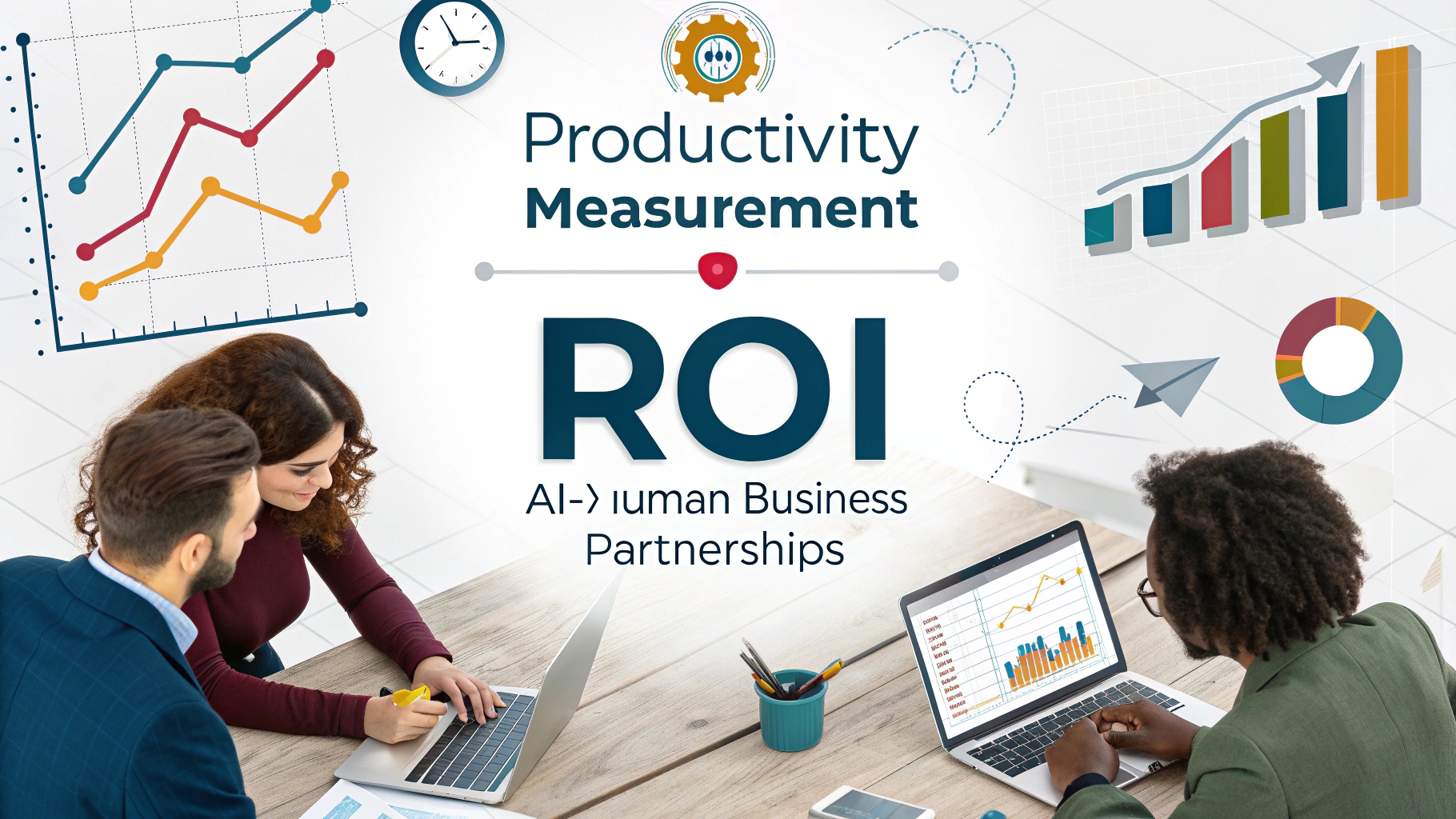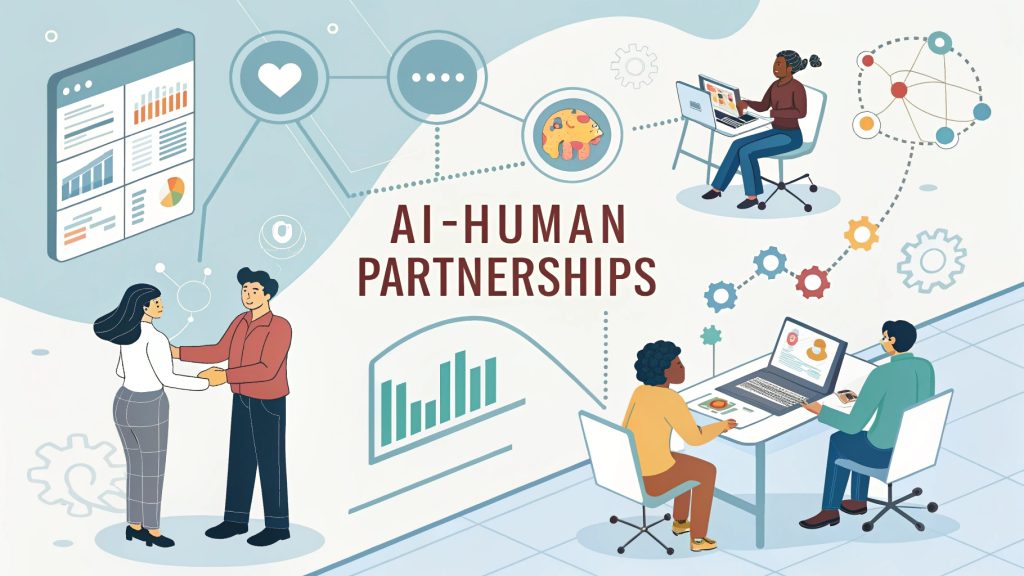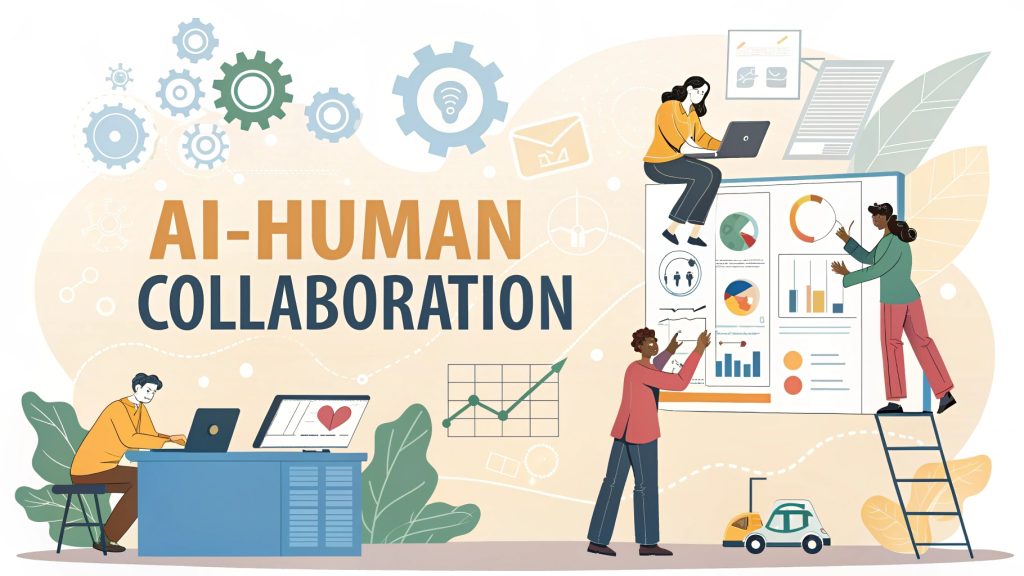
Are you struggling to prove the value of your AI-human partnerships to stakeholders? Companies that master ROI measurement for AI productivity in team collaboration see 3x better returns than those using outdated metrics. This comprehensive guide reveals proven frameworks, real-world case studies, and expert strategies to accurately measure and maximize your AI-human partnership investments.
Understanding the financial impact of AI-Human collaboration
Did you know that companies measuring AI-human partnership ROI correctly see 3x better returns than those using traditional metrics? Understanding the financial impact of productivity and enhancing teamwork with AI requires looking beyond simple cost calculations to capture the true value these partnerships create for your business.
Defining ROI in the context of productivity and AI integration
Think of measuring AI-human partnership ROI like evaluating a sports team’s performance. You can’t just look at individual player statistics, you need to understand how well they work together to win games. Traditional ROI calculations focus on simple input-output ratios, but AI-human collaboration creates value in ways that don’t immediately show up on your balance sheet.
When we talk about productivity in AI-human partnerships, we’re examining three critical areas that transform how businesses operate. Direct financial returns include cost savings from automation and increased revenue from improved decision-making capabilities. Operational efficiency covers time savings, error reduction, and resource optimization that compound over time. Strategic advantages encompass competitive positioning, innovation capabilities, and long-term growth potential that traditional metrics often miss.
“The quality of AI models often hinges on the quality and quantity of data available. As data accumulates, AI models improve, leading to more impact and business value over time.” – SandTech Research
Key metrics that matter for enhancing teamwork with AI
What gets measured gets managed, right? But when it comes to enhancing teamwork with AI, you need to track metrics that capture both human and artificial intelligence contributions working together. The most successful organizations focus on collaboration-specific indicators rather than just individual performance metrics.
Task completion rates tell you how effectively your human-AI teams finish projects compared to purely human teams. Quality metrics measure the accuracy and reliability of outputs when humans and AI collaborate. Time-to-completion shows whether AI actually speeds up your processes or creates new bottlenecks that need addressing.
Essential KPIs for measuring AI-human partnership success
Ready to dive into the numbers that actually drive business results? Measuring AI-human partnership success requires a balanced scorecard approach capturing multiple dimensions of value creation. Think of it like a car dashboard, you need different gauges to understand how well everything works together.
Revenue-based metrics : Direct financial returns
Let’s start with the metrics that make your CFO smile and justify continued investment in AI-human partnerships. Revenue-based measurements focus on how these collaborations directly impact your bottom line through measurable financial improvements that stakeholders can easily understand and appreciate.
Revenue growth from AI-enhanced decision-making serves as your primary indicator of success. This includes increased sales from better customer insights, improved pricing strategies, and more effective marketing campaigns powered by human creativity and AI analytics. When your sales team uses AI to analyze customer data while applying their relationship-building skills, conversion rates typically increase by 20-40%.
| Revenue metric | Measurement method | Typical impact range |
|---|---|---|
| sales conversion rate | before/after ai implementation | 15-35% improvement |
| customer lifetime value | cohort analysis | 20-50% increase |
| cost avoidance | risk-based calculations | 5-15% of operational costs |
Productivity metrics : Efficiency and output improvements
Now we’re getting to the heart of what makes AI-human partnerships special in terms of enhancing teamwork with AI. Productivity metrics show how well your teams work together to accomplish more with the same resources, like measuring how much faster a relay team runs compared to individual runners.
Output per hour serves as your baseline productivity measure, but don’t just count widgets, measure the quality and complexity of work completed. When your content team uses AI for research while focusing their creativity on strategy and storytelling, they might produce 50% more high-quality content in the same timeframe while maintaining creative standards.
“By delegating routine work to AI, humans can redirect their efforts towards more complex and creative endeavors, leading to increased efficiency and enabling individuals and organizations to achieve more in less time.” – BrainzMagazine
Cost reduction indicators : Operational savings through AI
Want to see immediate impact from your AI investments? Cost reduction metrics show where AI-human partnerships save money right now, with these savings often compounding over time to create substantial long-term value for your organization.
Labor cost optimization doesn’t mean replacing people, it means helping them focus on higher-value activities that drive business growth. When AI handles routine data processing, your analysts can spend more time on strategic insights that create competitive advantages. Error reduction costs are frequently underestimated but can be substantial across industries, with AI-human partnerships typically reducing errors by 40-70% compared to purely human processes.
Common problems when measuring AI-Human partnership ROI
Here’s the uncomfortable truth: even successful companies struggle with measuring AI-human partnership ROI accurately. Understanding these common pitfalls helps you avoid measurement mistakes that could lead to poor investment decisions or missed optimization opportunities in your productivity initiatives.
Data collection challenges in hybrid work environments
Picture trying to measure team performance when half your players are invisible, that’s what data collection feels like in many AI-human partnerships. The challenge isn’t just technical; it’s about capturing the complete picture of how humans and AI contribute to outcomes in increasingly complex work environments.
Remote and hybrid work environments make this measurement challenge even trickier. Traditional productivity metrics might miss crucial interactions between humans and AI systems that happen outside formal work processes but contribute significantly to results.
Attribution issues : Separating AI impact from human contributions
Here’s a puzzle that keeps many analysts awake at night: when your AI-human team achieves great results, how much credit goes to the AI versus the humans? It’s like trying to figure out whether a great meal was due to the recipe or the chef’s skill, both contribute essential elements.
The attribution problem becomes even more complex when multiple AI systems and human team members collaborate on the same project simultaneously. Interaction effects make attribution particularly tricky to measure accurately, as the real value often comes from the synergy between human and AI capabilities rather than their individual contributions.

Short-term vs long-term ROI measurement difficulties
Imagine judging a tree’s value based only on this year’s fruit production – that’s what happens when organizations focus exclusively on short-term ROI from AI-human partnerships. The most significant benefits often take months or years to fully materialize and compound over time.
Learning curve effects mean that AI-human partnerships typically improve performance over time as both systems and humans adapt. Strategic benefits like improved decision-making capabilities and competitive advantages are difficult to quantify in quarterly reports but can transform your business over time.
Proven framework for calculating AI-Human partnership returns
Ready to build a measurement system that actually works for your organization? This proven framework has helped companies across industries accurately calculate returns from their AI-human partnerships, turning measurement chaos into actionable insights that drive better business decisions.
Step 1 : Establishing baseline performance before AI implementation
You can’t measure improvement without knowing where you started – establishing solid baselines is like taking a “before” photo that provides the reference point for all your future measurements. Document current processes in detail, including time requirements, error rates, and resource consumption patterns.
“Pre-project metrics, often identified before implementing AI, are key for assessing progress and impact. These baseline metrics include customer satisfaction scores, sales performance and error rates.” – SandTech Research
Step 2 : Tracking productivity gains through enhanced teamwork
Now comes the exciting part, measuring how AI-human collaboration improves your team’s performance in ways that matter for your business. Track both quantitative and qualitative improvements that emerge from your partnerships, monitoring collaboration patterns to understand how humans and AI work together most effectively.
Step 3 : Quantifying cost savings and efficiency improvements
Here’s where your measurement framework starts paying real dividends for your organization. Calculate direct cost reductions from automation, error prevention, and resource optimization that AI-human partnerships enable. Measure opportunity costs avoided through better decision-making and risk management capabilities.
Advanced ROI measurement techniques for AI-enhanced teams
Want to separate your measurement capabilities from the competition? Advanced techniques help you capture the full value of AI-human partnerships, including benefits that traditional ROI calculations completely miss. These methods distinguish measurement professionals from amateurs in the field.
Time-to-value analysis for AI tool adoption
How quickly does your AI investment start paying off for your organization? Time-to-value analysis tracks how long it takes for AI-human partnerships to generate measurable benefits, providing crucial insights for planning future investments and managing stakeholder expectations effectively.
Quality improvement metrics in AI-Human workflows
Sometimes the biggest value from AI-human partnerships comes from doing things better, not just faster. Quality improvement metrics capture these often-overlooked benefits that can have massive long-term impact on your business success and competitive positioning.
Employee satisfaction and retention as ROI indicators
Here’s a metric that many organizations completely overlook: how do AI-human partnerships affect your team’s job satisfaction and retention rates? Happy employees are more productive, creative, and likely to stay with your company, all of which directly impact your bottom line.
Real-world case studies : Successful ROI measurement examples
Nothing beats real-world examples to demonstrate how ROI measurement works in practice across different industries. These case studies show how organizations have successfully measured and maximized returns from their AI-human partnerships, offering insights you can apply immediately.
Case study 1 : Manufacturing company’s 40% productivity boost
A mid-sized manufacturing company transformed their quality control process by combining AI-powered defect detection with human expertise. The AI system could identify potential defects 10 times faster than human inspectors alone, but the real value came from how human experts used these insights strategically to develop prevention strategies and improve supplier relationships.
Case study 2 : Marketing agency’s enhanced creative output
A creative marketing agency partnered AI content generation tools with their human creative teams to serve more clients without sacrificing quality standards. Results showed 50% faster project completion and 30% higher client satisfaction scores, with the unexpected benefit of improved employee satisfaction leading to reduced turnover.
Tools and technologies for tracking AI-Human partnership performance
Want to measure what matters without drowning in data overload? The right tools and technologies can transform your ROI measurement from a monthly headache into an ongoing source of actionable insights that drive continuous improvement and optimization.
Analytics platforms for monitoring team productivity
Modern analytics platforms go far beyond simple time tracking to provide deep insights into how AI-human partnerships create value throughout your organization. Look for platforms that can track both human activities and AI system performance in integrated dashboards that provide comprehensive views.
AI-powered dashboard solutions for Real-time ROI tracking
Imagine having a crystal ball that shows your AI-human partnership ROI in real-time throughout your operations. AI-powered dashboards automatically calculate complex ROI metrics by integrating data from multiple sources, enabling rapid optimization and course correction.
Expert tips for maximizing ROI from AI-Human collaborations
Ready to transform your AI-human partnerships into ROI powerhouses that drive sustainable business growth? These expert tips come from organizations that have successfully maximized returns from their AI investments, representing the secret sauce that separates good results from exceptional ones.
Best practices for setting realistic ROI expectations
The biggest mistake organizations make is setting unrealistic expectations for AI-human partnership ROI that set them up for disappointment. Start with conservative estimates and build confidence through early wins that demonstrate value, considering the full timeline for value realization in your planning process.
“We stick to clearly measurable productivity gains. This has led us to emphasize AI projects that reduce tedious tasks, help employees use their time better, and gain job satisfaction and engagement.” – Guy Melamed, CFO of Varonis
Optimizing team training for better AI adoption results
Your ROI depends heavily on how well your team adapts to working with AI systems effectively. Focus training on collaboration skills rather than just technical capabilities, measuring training effectiveness through partnership performance metrics rather than just completion rates.
Continuous improvement strategies for long-term success
The most successful AI-human partnerships get better over time through systematic approaches to optimization and improvement. Establish regular review cycles and create feedback loops that help both humans and AI systems learn from each interaction and improve continuously.
Measuring ROI from AI-human business partnerships doesn’t have to be complicated when you follow proven frameworks and focus on the right metrics. Start implementing these strategies today to unlock the full potential of your AI productivity investments. Ready to transform your measurement approach? Share your biggest ROI challenge in the comments below and discover how enhancing teamwork with AI can revolutionize your business results.


